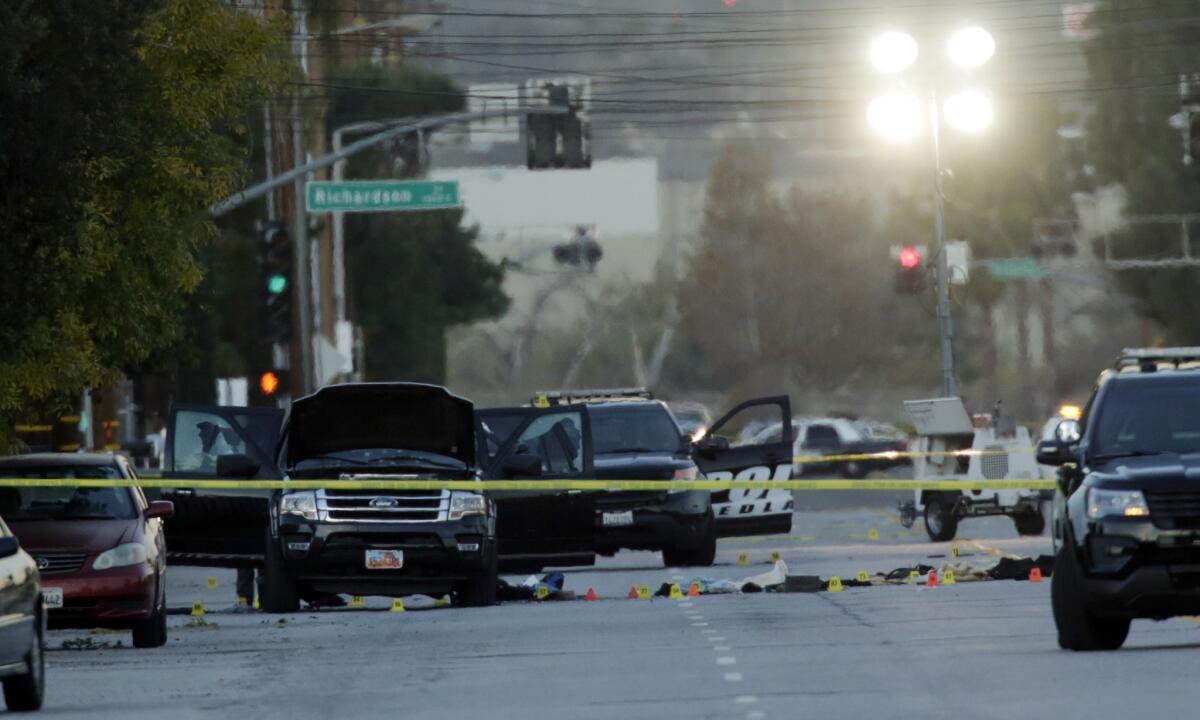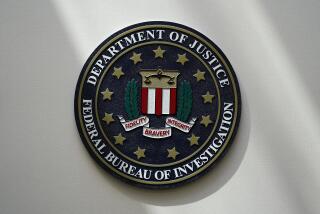San Bernardino massacre shows terror attacks could be harder to stop, analysts say

The investigation continues Thursday morning on San Bernardino Avenue, where two suspects in the mass shooting at the Inland Regional Center died in a shootout with police.
Reporting from Washington â The young couple who slaughtered 14 people in San Bernardino fit a profile now distressingly familiar from other recent acts of terrorism in the United States.
Syed Rizwan Farook, 28, and his wife, Tashfeen Malik, 29, were devout Muslims but not outwardly radical. They were members of a close-knit family with ties to the community. They built and stored crude pipe bombs in their home. And their attack apparently was inspired by, but not directed by, extremists abroad.
The couple thus had more in common with the Army psychiatrist who shot up a military facility at Ft. Hood, Texas, in 2009, and the North Caucasus brothers who set off homemade bombs at the Boston Marathon in 2013, than with the Belgian and French gunmen who killed 130 people last month in Paris.
Follow live coverage of the San Bernardino shootings >>
In contrast with the Paris attacks, no evidence yet indicates that Farook and Malik were part of a larger conspiracy organized by Islamic State or another militant group, or were part of a bigger terrorist cell in California.
That helped them avoid detection before Wednesdayâs massacre. Indeed, the absence of warning signs has become a hallmark of recent domestic plots, analysts said.
âSo far we have no indication these killers were part of an organized larger group or formed part of a cell,â FBI Director James B. Comey said Friday. âThere is no indication they were part of a network.â
Investigators have learned that Farook had made contact â in some cases by phone and in others via social media â with people who came up tangentially in previous federal terrorism investigations. But he had not drawn any scrutiny.
And officials said that his Pakistani-born wife had posted a comment swearing fealty to Islamic State on a Facebook page â but only just before the couple stormed into a holiday party at the Inland Regional Center, guns blazing.
There was ânothing of such a significanceâ that it drew FBI attention before the attack, Comey said.
No evidence suggests that the couple joined jihadist chat rooms or posted on websites popular with Islamic militants, according to Seth Jones, a terrorism analyst at Rand Corp., a Santa Monica-based think tank.
âThe challenge the U.S. faces is that there are radical individuals who are being a lot more careful, and it makes them virtually impossible to detect,â Jones said.
With Al Qaeda now overshadowed by Islamic State, the threat to Americans increasingly comes from self-radicalized individuals with no clear ties to outside groups. Their plots are less organized and possibly less deadly, but paradoxically also harder to stop, analysts say.
âThere are no direct communications or orders that you can intercept to realize that thereâs a plot going on,â said Bruce Hoffman, a terrorism expert at Georgetown University. âThereâs an absence of red flags.â
Investigators may find that Farook and Malik left digital or other tracks that have not yet emerged.
After Maj. Nidal Malik Hasan killed 13 people and injured more than 30 at a military processing center at Ft. Hood on Nov. 5, 2009, for example, investigators found that a Joint Terrorism Task Force knew he had been in direct contact with Anwar Awlaki, an Al Qaeda leader in Yemen who was later killed in a U.S. drone strike.
And after Dzhokhar and Tamerlan Tsarnaev killed three people and wounded more than 260 at the Boston Marathon on April 15, 2013, the Russian government said it had warned the FBI two years earlier that Tamerlan and his mother were âadherents of radical Islamâ and that he was preparing to join unspecified âbandit underground groupsâ in Dagestan and Chechnya.
The FBI failed to follow up on the warnings, a subsequent investigation showed.
Still, the pattern of Islamic extremists operating in the U.S. without outside direction is a clear change from the period after Sept. 11, 2001, when Al Qaeda and its supporters repeatedly sought to bomb airliners or other U.S. targets with operatives who were trained and directed by militants abroad.
Those included the incident in late 2001 when a British citizen tried to detonate explosives in his shoe on a flight to Miami; a foiled 2009 plot to bomb New York City subways by an Afghan American who had trained at Al Qaeda camps; and the 2010 attempted car bombing in New Yorkâs Times Square by a Connecticut resident who had traveled to Pakistan for training.
Al Qaeda in the Arabian Peninsula, the networkâs affiliate in Yemen, hatched two other failed plots â the 2009 attempt to down a Northwest Airlines flight over Detroit by a Nigerian man with a bomb in his underwear, and a 2010 attempt to explode bombs hidden in printer cartridges aboard two U.S.-bound cargo jets.
Even before Wednesdayâs attack, the FBI had about 900 active investigations of suspected Islamic State sympathizers or supporters and other homegrown extremists. Authorities have arrested 71 people on charges related to the group since March 2014, including 56 this year.
The groupâs social media, propaganda videos and direct appeals have exhorted followers to launch attacks in their own countries. In recent weeks, militants have bombed a Russian aircraft over Egypt, conducted bombings in Lebanon and Libya, and shot up restaurants and other sites in Paris.
Last fall, Islamic State released a video by a spokesman, Abu Muhammad Adnani, that called for revenge against countries that sent forces to Iraq and Syria to fight them, including Australia, France, Canada and the United States.
Michael C. Leiter, a former senior counterterrorism official in the George W. Bush and Obama administrations, said that signaled a greater danger in some ways because Islamic State wasnât trying to send operatives into the United States.
âPeople ask, âIs it directed or is it inspired?â I think thatâs entirely the wrong rubric because their direction is to inspire,â Leiter said. âThey are not looking to direct attacks at all.â
MORE ON SAN BERNARDINO
Rampage killers led secret life, hiding plans and weapons
Media criticized for live TV coverage from home of San Bernardino shooters
Victim talked about Islam with assailant 2 weeks before San Bernardino shooting
More to Read
Sign up for Essential California
The most important California stories and recommendations in your inbox every morning.
You may occasionally receive promotional content from the Los Angeles Times.












